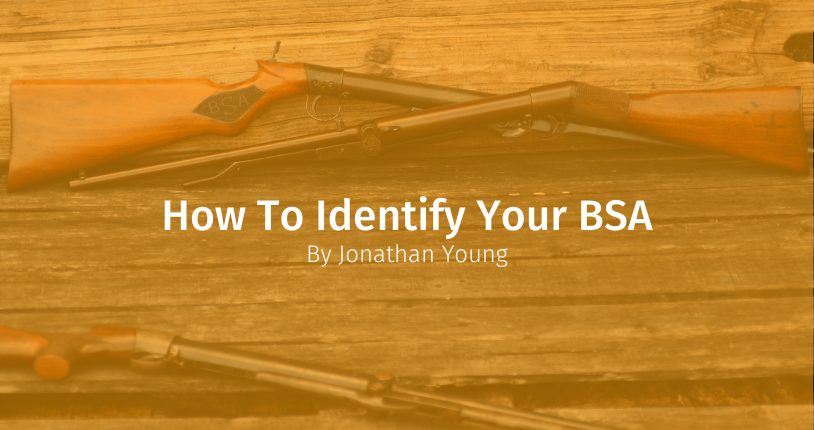
AirMaks Arms at The British Shooting Show
News Events
Create a FREE business profile and join our directory to showcase your services to thousands.
Create my profile now!
Following on from a previous blog entry which was an introduction to the wonderful world of vintage BSA pre-War air rifles lets take a closer look at some guns to help identify the many versions, by the differences that are not so obvious to the casual onlooker. So to recap small features really help identification when to be fair most of these do appear to look similar.
When faced with a rusty shed find or an attic heirloom being sold at auction, the cocking arm where it pulls away from the barrel has a catch release to the underside of the barrel. The three styles of lever - four if you have eyes glued in really tight - are instantly recognisable and all different. Original Lincolns and the first BSA Air Rifle have a spade handle release because it sort of looks like a long spade. Some also refer to this as a bayonet release for similarly obvious reasons. This was found to bend slightly so the design was strengthened, partly obscuring the anchor stud fitted to the barrel where the arm locates to. Later the arm was modernised to have the sprung latch mounted into the lever arm itself from the side. Finally, this release became a neat round button catch to the end up until the end of production.
Look Close, early .177 no mark, No.1 .177, No.2 .22 and .25 No.3 Bore
Barrel length can offer some clues and sat beside each other a shorter rifle at just over 39” instantly identifies it as the smaller L Pattern or Ladies Pattern being inches shorter than the regular length.
Stocks shapes can differ when viewed up close. Early stocks have a pistol grip shape sometimes referred to as a monk's cowl design. Just look at the stock from the side and note the grip with the overhang to the thumb area – looks like a monk's hooded cowl. The sharp edges to this stock gave way to a series of more rounded profile stock shapes over time. Large BSA logos were later roll impressed into the grip area. However, a more traditional looking straight stock was optional from the beginning. Early guns had added steel butt plates but this was dropped and later the raw end of the wood itself was grooved for grip and this version has a wooden oval plug covering the hole for the stock fixing bolt.
From the bottom - Lincoln H .177, Improved D Junior .177, Standard L Pattern .177 with added flip-up sight
Improved D .25, Improved D Junior .177, both in elegant straight stocks
Earlier guns don’t normally have calibre markings as .177 was the only calibre offered initially but later with new options on offer an identification mark was stamped ahead of the pellet loading hole. A stamp ‘1’ identifies the calibre as .177 or No.1 Bore in old language. A '2' signifies No.2 Bore or .22, and '3' is for No.3 Bore or .25. However, there are errors, factory omissions and anomalies so caution is advised especially as some very rare .25's have escaped notice at auction selling as more ordinary guns due to lack of inspection.
If an air rifle has an end button release and no stamped lettering or visible markings to the cylinder, that will be a later BSA Standard that has simply lost its etching. A spade or bayonet release rifle with a rusted barely readable stamp to the cylinder and with '3' just still visible to the loading hole would mean an early BSA Improved Model D in .25 calibre.
Earliest BSA and Lincoln stock stamps
Most of these airguns are perfectly usable today with perhaps only minor attention needed before serious use. Many seals can be original and still usable. The leather sheets used for these could have been processed years before and may have come from cows that grazed when Britain was fighting the Zulus. If missing sights, these are difficult to replace and expensive to buy when found, however there’s absolutely nothing wrong in rescuing a good gun back to usable condition with something that can be adapted and used as a stand-in for a time. Later on, when rummaging over tables at one of the many arms fairs, these missing original parts may turn up unexpectedly. The adjustable rear sights and the foresight blades were matched on these wonderful rifles offering open sight shooting for target work and vermin control. However, traditional scopes were fitted when available to vintage period air rifles and long before cheap modern airgun scopes were made.
Early to later shoulder stocks - steel plate, no plate with a wood core plug
The air transfer hole through the end of the cylinder is of large diameter. Loading a pellet before cocking creates suction and the pellet - especially if .177 - can actually get pulled back into the cylinder, embedding itself into the leather. For the same reason, small nails are sometimes found jammed inside these guns when people couldn’t afford pellets. With many springs being original, some snap with use today, however it doesn’t take much to service one of these old timers as spares are still thankfully available for many.
Text & Images @ Copyright Jonathan J. Young 2020


